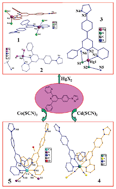Metal cation- and anion-induced assembly: structures and luminescent properties†
Abstract
Three complexes HgLBr2 (1), [HgLI2]·CH3CN (2) and HgL(SCN)2 (3) were synthesized by

Maintenance work is planned from 09:00 BST to 12:00 BST on Saturday 28th September 2024.
During this time the performance of our website may be affected - searches may run slowly, some pages may be temporarily unavailable, and you may be unable to access content. If this happens, please try refreshing your web browser or try waiting two to three minutes before trying again.
We apologise for any inconvenience this might cause and thank you for your patience.
a
Department of Chemistry, Anhui University and Key Laboratory of Functional Inorganic Materials Chemistry of Anhui Province, 230039 Hefei, P. R. China
E-mail:
zhpzhp@263.net
Fax: +86-551-5107342
Tel: +86-551-5108151
b Department of Chemistry, Fuyang Normal College, Fuyang 236041, P. R. China
c State Key Laboratory of Coordination Chemistry, Nanjing University, Nanjing 210093, P. R. China
d State Key Laboratory of Crystal Materials, Shandong University, Jinan 250100, P. R. China
Three complexes HgLBr2 (1), [HgLI2]·CH3CN (2) and HgL(SCN)2 (3) were synthesized by

 Please wait while we load your content...
Something went wrong. Try again?
Please wait while we load your content...
Something went wrong. Try again?
F. Jin, H. Wang, Y. Zhang, Y. Wang, J. Zhang, L. Kong, F. Hao, J. Yang, J. Wu, Y. Tian and H. Zhou, CrystEngComm, 2013, 15, 3687 DOI: 10.1039/C3CE26685K
To request permission to reproduce material from this article, please go to the Copyright Clearance Center request page.
If you are an author contributing to an RSC publication, you do not need to request permission provided correct acknowledgement is given.
If you are the author of this article, you do not need to request permission to reproduce figures and diagrams provided correct acknowledgement is given. If you want to reproduce the whole article in a third-party publication (excluding your thesis/dissertation for which permission is not required) please go to the Copyright Clearance Center request page.
Read more about how to correctly acknowledge RSC content.
 Fetching data from CrossRef.
Fetching data from CrossRef.
This may take some time to load.
Loading related content
